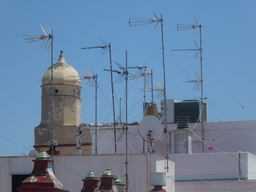Some antennas for MURS, 2-meters, 70 cm, and UHF-TV
| Antenna Overview |
| VHF (2m/MURS) |
| Moxon Rectangle |
| Yagi-Uda |
| High-Gain Omni |
| UHF (70 cm) |
| Dual-Rectangle |
| HDTV |
| Hoverman |
| Gapless Hoverman |
| Extended Hoverman |
| jed |
| S-Lang |
| most |
| Complex Domain Coloring |
| SLxfig |
| Antennas |
| Thermochron |
| Main Page |

This page contains some antenna designs for the 2 meter amateur (144-148 MHz), MURS (151.82, 151.88, 151.94, 154.570, 154.6 MHz), 70 cm (420-450 Mhz), and post February 2009 UHF-TV bands.
While an amateur license is required to transmit on the 2 meter and 70 cm bands, the MURS frequencies are unlicensed. The FCC permits a maximum of 2 Watts (TPO) power output by a MURS transceiver, but it places no limit to the gain of an external antenna attached to the radio. For these reasons (and there are others), I believe the unlicensed MURS band to be superior to other unlicensed bands such as FRS.
The closeness of the MURS and 2-meter bands make it sometimes possible to use the same antenna on both the VHF bands. This is particularly true of the lower 3 MURS channels. Some of the antennas presented here were designed to be used for both 2-meters and MURS.
The antennas were designed using NEC-2 on a Debian Linux system. A S-Lang script was written to run NEC-2 for a specified geometry, and from its output, compute a statistic. The script repeated this process until the statistic was minimized. This procedure produced the optimal geometric parameters for the antenna configuration.
For example, to design my yagi, I created a statistic that when minimized, produces an antenna with a high-gain on MURS channels 1-3, has an SWR less than 1.2 on those channels, and a relatively low SWR across the 2-meter band. Moreover the input impedence of the antenna at the design frequency was to be close to 50 ohms to permit one to directly attach a 50 ohm coaxial cable to the antenna.
My antennas are installed in the attic as that is currently the only practical place for me to put them. This is rather unfortunate because the antennas were designed for free-space. As such the properties of the antennas are generally different when installed in the attic than somewhere high up over the roof away from other objects. If you have a choice, do not put an antenna in the attic. However, an antenna destined for the attic does have one redeeming feature: it need not be weatherproof, which vastly simplifies its construction.
The first antenna (aside from the obligatory ground-plane and j-pole) that I constructed was the moxon rectangle. It is a relatively small antenna with a gain of about 6 dBi, and has a mostly one-sided radiation pattern with a front-to-back ratio greater than 25 dBi. You can read more about it on my Moxon page.
The second antenna I created was a 5-element yagi, which at its design frequency has a gain of over 11 dBi and a front-to-back ratio of about 16 dBi. More details are provided on my Yagi-Uda page.
If you are looking for a simple to build, high-gain omni-directional antenna then I encourage you to consider my design. The one described on this page has more gain than the popular j-pole and does not have the tuning problems that seem to plague many J-poles.
At the moment, the only antenna that I have for 70 cm is composed of two dual-rectangles that are electrically connected together. The antenna is quite compact with a gain approaching 9 dBi and a front-to-back ratio exceeding 20 dBi. More information about it is on my Dual-Rectangle page.
Note: The gain values reported on these pages are with respect to an isotropic radiator. This is indicated by ``dBi''. Some pages quote gain values with respect to a dipole, and denote such values using ``dBd'', while others use just ``dB'' and do not indicate what the value is relative to. Since the gain of an ideal dipole is 2.15 dBi, you can subtract 2.15 dBi from the gain values on these pages to obtain gain values in units of dBd. For example, a gain of 12.15 dBi is equivalent to 10 dBd.